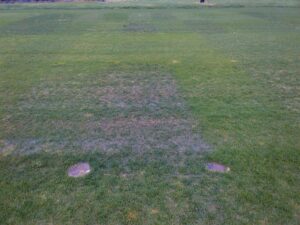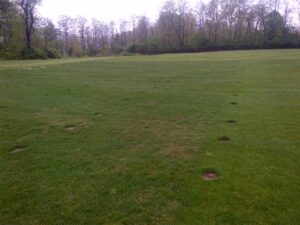The Cougar Blight model at NEWA is predicting “Extreme Risk” for fire blight for the period May 10-15. The model is basing the prediction on the current weather forecast for both southern and northern regions. Keep a close eye on the weather. Apply antibiotics such as Streptomycin, Mycoshield, or Fireline. Streptomycin is the most effective of the antibiotics. The Terramycin products (Mycoshield and Fireline) should be rotated with strep for resistance management. See the New Jersey Commercial Tree Fruit Production Guide for rates. Keep in mind that these antibiotics are best applied under slow drying conditions (dilute applications), and have limited residual activity.
Archives for May 2013
Slow Green-up of Kentucky Bluegrass
By Jim Murphy
There are numerous elite varieties of Kentucky bluegrass (Compact Types) that have excellent tolerance of leaf spot, summer patch, and stripe smut diseases. Many varieties produce a very attractive, dense, compact (low growing) turf with dark green color during the summer.
Some elite varieties of Kentucky bluegrass exhibit slow spring green-up (plot in center foreground).
However, many of these Kentucky bluegrass varieties that are grown and sold as sod have the growth characteristic of long winter dormancy and slow spring green-up. The cool dry weather of this spring has certainly exacerbated this growth response. Full green-up of these varieties typically occurs by mid- to late-May.
Practices that hasten spring green-up of turf include fertilization with moderate amounts (0.4 to 0.7 pounds per 1,000 square feet) of water soluble nitrogen (WSN) and covering the turf with a growth blanket early in the spring (March and April).
Perennial ryegrass and tall fescue will often green-up several weeks earlier than these Compact Type Kentucky bluegrasses. Perennial ryegrass typically will have the earliest green-up.
Of the fine fescues used for turf, creeping red fescue will green-up earlier than Chewings fescue and hard fescue will have the slowest spring green-up. Green-up of creeping red fescue is relatively early and not too different from perennial ryegrass.
Slow Growth This Spring
By Jim Murphy
Slow growth of grasses has been a common complaint this spring. There are many factors that can cause this but cool dry weather has been a major factor this year.
Slow growth of turf can be due to many factors but cool dry weather has been important this spring.
But this is changing as I type. The abundant rains of this week will stimulate a lot of shoot growth. Be on the watch for large surges of growth from turfs that have been fertilized with relatively large amounts of nitrogen fertilizer. Water, warmer weather, and nitrogen can stimulate plenty of shoot growth.
Moreover, rains could interrupt mowing schedules. Sharp blades and bedknives will be very helpful in cutting fast growing, dense turfs. Overgrown turf will present the greatest challenge to mulching mowers. Raise the cutting height if rains significantly delays mowing and turf becomes severely overgrown. Double cutting may be another useful practice to reduce clipping debris.
Avoid mowing turf areas that are squishy wet. Operating equipment under these conditions can cause significant traffic damage to the turf and soil.
Fruit IPM Report for 5/9/2013
- Peach
- Apple
- Scouting Calendar
- Blueberry
- Trap Counts
Skin blotch in garlic
Skin blotch of garlic caused by the fungus, Embellisia allii, has been found in a homeowner’s garden. Symptoms on infected plants include the a diffuse coating of charcoal-colored flecks on the outer surfaces of infected stems. [Read more…]
A Generic Clopyralid (STINGER) Product Called SPUR is Labeled for Asparagus
Clopyralid, marketed under the trade name STINGER, was labeled for use in asparagus for years. About eight years ago Dow removed asparagus from the Stinger label due to liability concerns. A generic version of clopyralid called SPUR, produced by Albaugh Inc., is now available and includes asparagus on the label with a 48 hour PHI.


